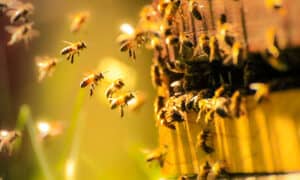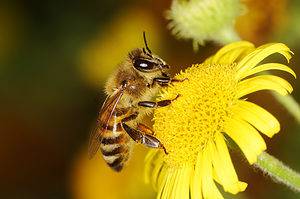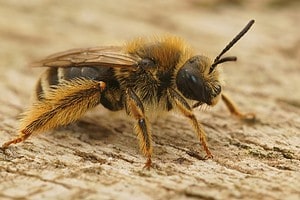Bees are vital for the pollination of flowers and crops. At the same time, they can be a real bother — and even harmful — once they start building their nests within the walls of your home.
If you have bees in your wall, you’re probably wondering how to get rid of them quickly and safely. This post will share essential tips and tricks on regaining your home from these unwanted visitors without harming yourself.
What Are Bees and Why Are They in Your Wall?
Bees are winged insects that are vital in pollination and honey production. They belong to a group of flying insects called Hymenoptera. Other insects in this group include ants, wasps, and sawflies.
Bees are widespread for their role in pollination, honey production, and wax production. These insects sometimes sting when provoked. There are more than 20,000 bee species in the world, and they come in different sizes, colors, behaviors, and habitats.
How Do Bees Get into Walls?
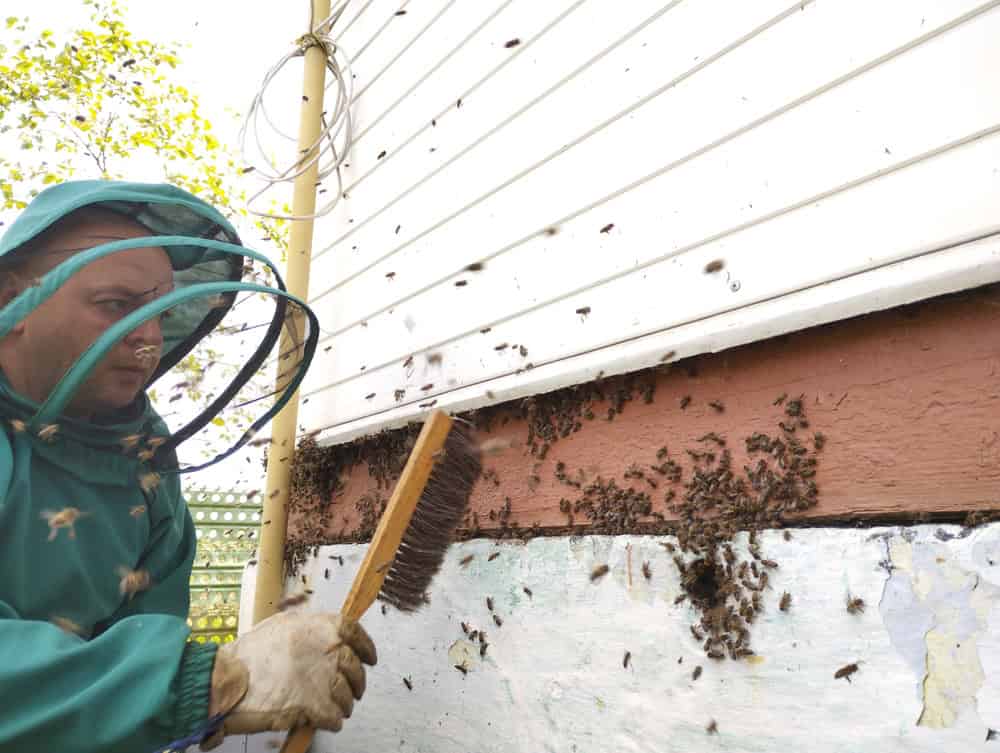
Bees can get into your walls through openings and structural cracks.
©Oleg 08/Shutterstock.com
Bees might sneak inside walls through tiny openings like gaps or cracks in windows, crevices, roofing, vents, or doors. These openings may come about as a result of natural wear and tear, poor construction, or weather damage. Bees can go as far as drilling holes in wood and other materials to gain access to homes.
Bees thrive in dark, dry, and safe conditions, which are most prevalent in wall cavities. If your walls have a nest from a previous bee infestation, this alone might increase your chances of a fresh habitation.
What Types of Bees Are Likely to Nest in Your Walls?
Honey, bumble, carpenter, and mason bees are notorious for their tendency to build their nests in wall cavities. You must understand each bee’s distinct traits and behaviors to completely eradicate them from your walls.
Honey Bees
Honeybees live together in groups of up to 100,000 bees. They gather nectar and pollen from flowers to produce honey and wax. Honeybees typically create their homes in hollow spaces like tree trunks, logs, and fences. Honeybees may enter your roof, attic, or wall cavity through cracks or holes in the presence of an outside opening. These bees are easily identifiable by their black and yellow stripes and furry and plump bodies.
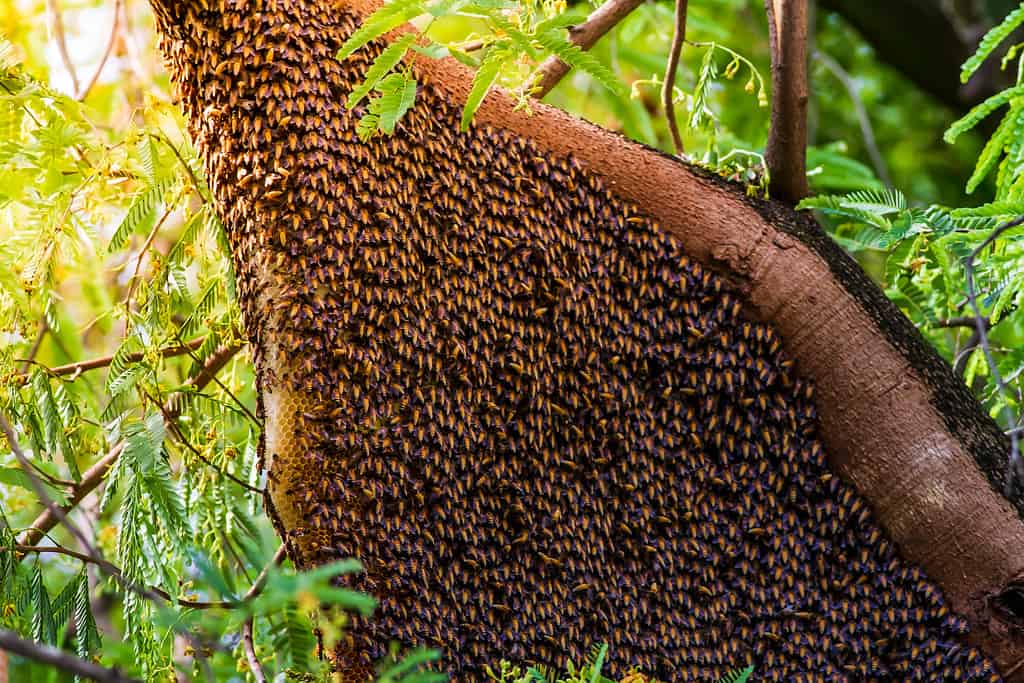
A close-up view of a colony of industrious honey bees, working together to ensure the health and growth of their hive.
©vivatchai/Shutterstock.com
Bumblebees
Bumblebees are social insects that dwell in smaller colonies of up to 400 bees. They neither produce honey nor wax but pollinate plants and crops. Bumblebees often nest in the ground, under stones, or in abandoned rodent burrows. They may also use wall cavities or similar structures if they find a suitable entrance. Bumblebees are distinguishable from honeybees by their larger size, rounder shape, and varied colors.
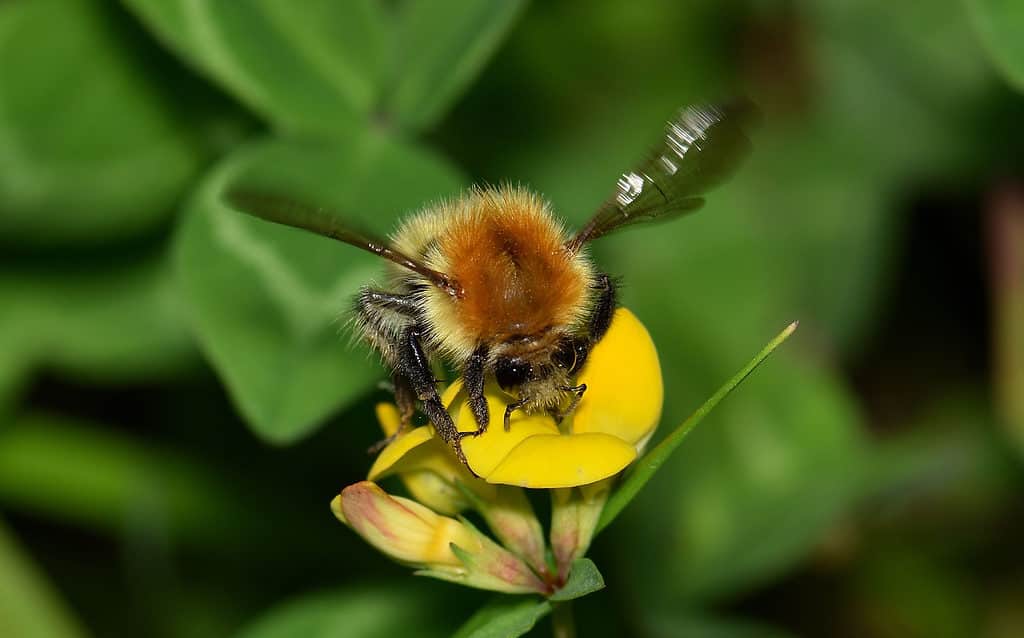
A bumble bee pollinates a bright yellow flower, helping to keep the natural world in motion and our ecosystems in balance.
©iStock.com/Wirestock
Carpenter Bees
Carpenter bees are solitary insects that neither form colonies nor produce honey or wax. They create holes in wood to create tunnels where they can lay their eggs and store their food. Carpenter bees can substantially destroy wooden structures like beams, siding, or fences. They might exploit wall cavities if they stumble upon exposed wood or openings. Carpenter bees have distinctive features such as a black hue, a shiny abdomen, and a comparatively less hairy physique.
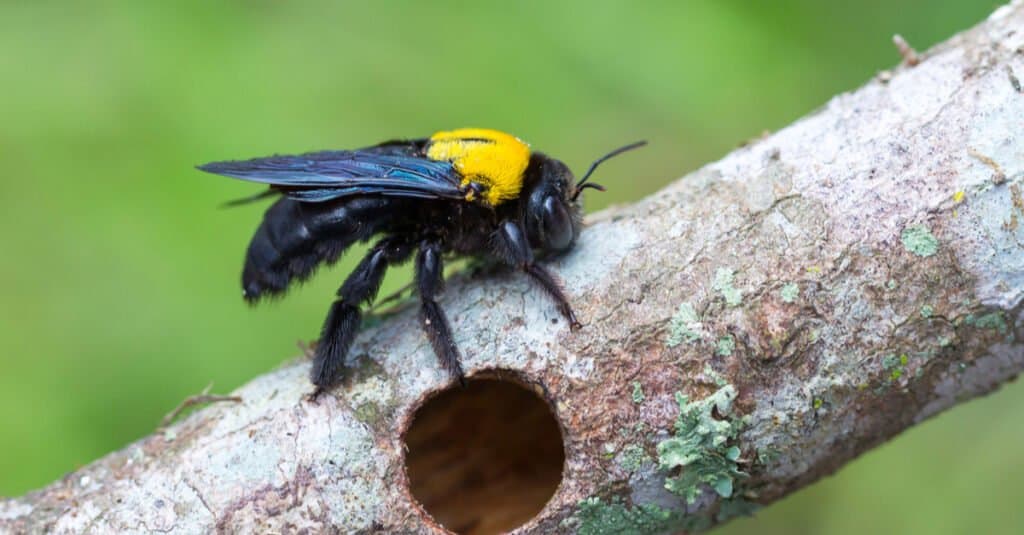
The carpenter bees are large, black-and-yellow bees that bore into softwoods such as pine, cedar and redwood to create galleries for their larvae.
©Zety Akhzar/Shutterstock.com
Mason Bees
As their name suggests, mason bees build their nests using mud or natural materials. Unlike the other bees on this list, mason bees are solitary creatures that don’t live in colonies. Instead, they construct single nests in natural or human-made burrows. Mason bees are roughly the same size as houseflies and have metallic blue, green, and black hues.
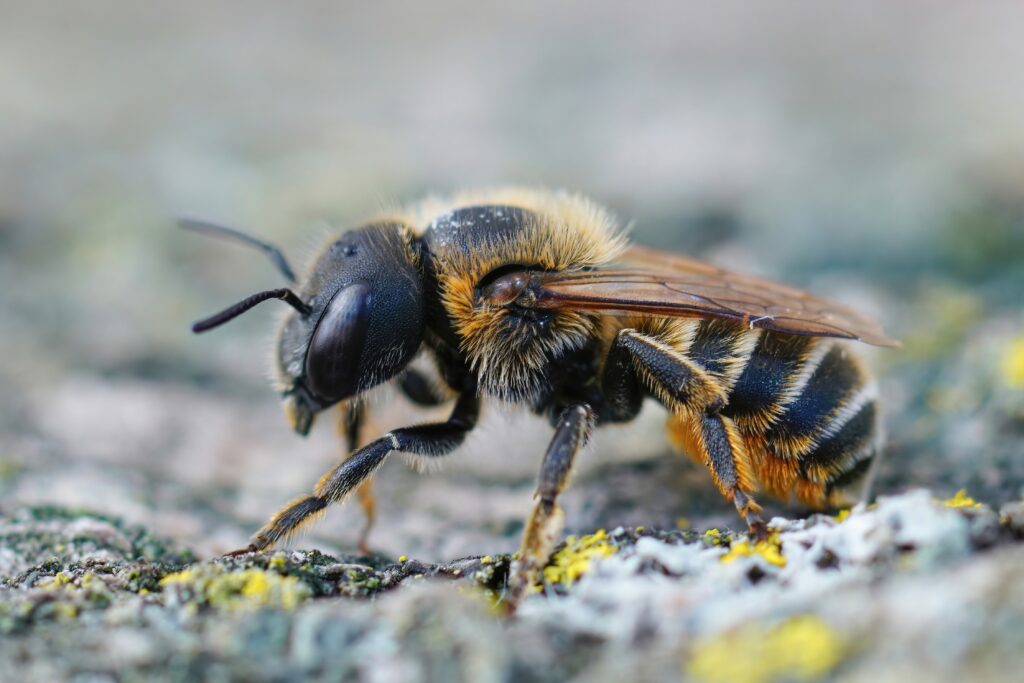
The mason bee is a solitary bee species often found nesting inside pre-existing holes, such as those created by wood-boring beetles or abandoned nests of other insects.
©HWall/Shutterstock.com
What Are the Risks of Having Bees in Walls?
Finding a beehive inside your house walls can be unsettling, especially if someone in your family has a bee sting allergy. Besides causing harm or illness, these insects can also harm the integrity of your property. Here’s a brief explanation of why it’s crucial to eliminate the bees in your walls promptly:
- Someone in your household may get stung: When you attempt to remove bees from small spaces within walls, they easily become defensive when disturbed. If you have a bee infestation in your home and someone in the household has a bee sting allergy, it’s essential to act quickly. A single bee sting can cause a life-threatening reaction for someone allergic.
- Leads to structural damage: Honeybees frequently attach their wax combs to wooden surfaces or other materials as they construct their hives. This attachment can cause the weakening of the wall over time, and if not addressed on time, it could result in significant structural damage.
How to Get Rid of Bees in Walls
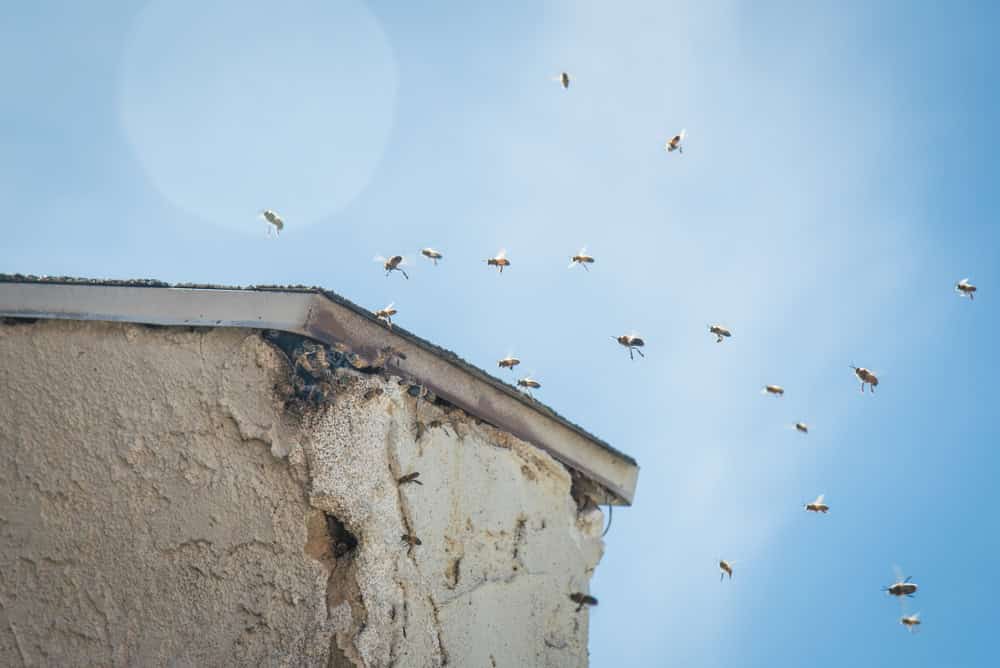
When dealing with a home bee infestation, the utmost caution should be exercised.
©Atsushi Hirao/Shutterstock.com
You must stay calm and keep your distance if you see bees in your wall. Don’t try to relocate their nest; they might get scared and use their stingers to attack. Here are other tips to eliminate bees from your walls:
Investigate the Bees’ Exact Location
Upon first suspicion of a bee infestation in your walls, an investigation is more than necessary. By searching for physical hives, you can gauge the extent of the problem and determine the exact location of the issue. One of the initial indications of a bee infestation could be constant buzzing sounds and faint crawling or scratching sounds within your walls. Bees typically generate their distinct buzzing sound when flying or communicating.
If you suspect you might be dealing with specific bees like carpenter or mason bees, examine wooden structures for any signs of damage; this is an unmistakable indication of their presence.
Chemical Sprays
This method of eradication is super effective for small bee populations. However, we strongly recommend contacting professionals if you’re dealing with a large group or a nest.
Several scents, such as lemon, mint, pepper, and garlic, repel bees. You can create your DIY spray or use cotton balls as bee repellents. Mix water and essential oil fragrances to make your spray, then shake and spray near areas where bees are most prevalent. Alternatively, soak cotton balls in the essential oil and place them around your home.
While these methods may not eliminate bees, they can help to isolate them and mask other attractants. To prevent bees from entering your wall, spray your repellent around the entry point on your home’s exterior.
Smoke

Beekeepers utilize smoke to relocate or control bees before they’ve built their honeycomb.
©Simon Kadula/Shutterstock.com
The concept of smoking bees out is quite simple. Create a smoky atmosphere to discourage or move the bees away from the area where they’re trying to establish a colony in a building. This technique is sometimes used for swarm removal or to remove bees from a void in a building.
While some beekeepers and homeowners may be successful with this method, it only works if the bees have not built their honeycomb yet. Once they start making honeycombs, smoking them out won’t work, considering the smoke won’t fully penetrate the colony. Even if the bees move away from the comb, they’ll return once the smoke dissipates.
Borax Powder
Borax is often touted as one of the most potent insecticides, capable of effectively killing a wide range of bugs. Deposit some borax powder directly into the bee’s nest for this natural remedy and wait a few days; all the bees will be exterminated.
Ensure you take the necessary precautions to protect yourself as you apply the powder. This includes wearing gloves, a face mask, and thick socks to prevent accidental contact with the powder. Once the bees come into contact with the powder, it will instantly take effect.
Use the Trap-Out Method
The trap-out method helps eliminate bees from confined spaces without destroying building materials or performing restoration work on your wall.
This method involves creating a trap that allows the bees to exit the confined space and prevents their re-entry. Use a nucleus box to execute this method, expecting the bees to re-colonize it rather than the limited space in your wall. The entry or exit point of the hive is fitted with a cone, with the wide end covering the opening and the narrow end inserted into the nucleus box.
For instance, as the bees depart from the hive, foragers will travel out of the exit point and into the box. However, they will be unable to return.
Use a Cucumber
To use cucumbers as a home remedy to get rid of bees, follow these steps:
- Slice the cucumbers into small, circular shapes.
- Put the slices on an aluminum surface.
- Place the pieces at a strategic point near the bee nest.
When the aluminum surface and chopped cucumbers react, it produces a repulsive scent to the bees. Alternatively, you can peel the cucumbers and position the peels on your windowsill. Bees are averse to the odor that emanates from the cucumber peels; this will help to keep them away from your home.

Cucumbers contain cucurbitacins, which are naturally occurring compounds that irritate bees and other insects.
©Africa Studio/Shutterstock.com
Use a Bee Vacuum
A bee vacuum is a unique kind of vacuum cleaner designed to safely remove honey bees without causing harm to them. It is beneficial when dealing with an unwanted bee colony or a calm swarm in a challenging location.
A bee vacuum sucks in bees by creating a vacuum using negative pressure, just like a regular vacuum cleaner. However, its suction power is low and cannot be used for everyday cleaning tasks. The bee vacuum must maintain a delicate balance, powerful enough to suck in bees but gentle enough not to hurt or kill them.
Liquid Soap and Water
Bees breathe air through tiny holes in their abdomen called spiracles, which let oxygen into their system. When soap and water are mixed, the tension on the surface of the water decreases, which can help the water get inside the spiracles more easily. The water will drown the bee to its death. Here’s how you can use liquid soap and water to sort out your bee problem:
- Step 1: Pour three cups of liquid soap into the hose sprayer, then add water. Don’t worry about being exact with the amount of water you use.
- Step 2: Wear the right protective gear; this may include long pants, a shirt with long sleeves, gloves, and something on your head. You might also need to put on special glasses to boost your safety.
- Step 3: Shake up the soap mixture. Make sure it is soapy and foamy.
- Step 4: Spray the bees with the soapy water. Try to spray them from ten feet away. Drench them with the soap mixture and have a way to escape. The soap will break down the bees’ wax coating, and they will drown. It would be best to have a lot of soap to kill them before they swarm and sting you.
- Step 5: Get away. If you don’t get all the bees immediately, have a way to escape. Please don’t bother the bees until they’re calm or dead. Repeat the soap treatment if necessary.
Calling a Professional
The most effective way to eliminate bees in your wall is to contact a professional beekeeper or pest control service. They can safely and humanely remove the entire hive. If they’re honey bees, you can ask the professionals to move them elsewhere so they can carry on their work of pollination. If there are bumble, carpenter, or mason bees, you can ask them to release them in a suitable habitat away from your house.

The job of a bee exterminator isn’t for the faint of heart – but with the right protective gear, no task is too tough.
©LightField Studios/Shutterstock.com
How to Prevent Bees from Nesting in Walls
It’s essential to prevent bees from building nests inside your walls from the beginning. Here are some steps you can take to avoid this problem:
Seal Potential Entrances
Bees can fit through tiny spaces as small as a quarter-inch gap. It’s therefore crucial to examine your walls for cracks, crevices, or holes that could offer an opening to bees or any other insect. Use durable materials such as metal screens, caulk, or polyurethane spray foam to seal these entrances and make it harder for bees to get in. Check areas you may not consider as much, such as your attic, basement, chimney, vents, or eaves.
Reduce Outdoor Clutter
Bees look for sheltered places to build their nests. They may find them in outside equipment like unused appliances, lawn equipment, furniture, etc. Removing these items from your yard helps lower the chances of bees finding a suitable nesting spot on your property. You can also trim any overgrown vegetation that could provide cover for bees or their nests.
Apply Treatment to Scout Bees
Scout bees often search for new nesting locations and communicate them to the rest of the swarm by doing the waggle dance. If you notice bees flying around your walls or inspecting potential entrances, you can spray them with a bee repellent or an insecticide labeled for bee control. This will prevent the scout bees from informing the swarm of the potential nesting spot and make them move to another location.
Removing Bees in Walls Isn’t that Hard!
If you want to keep bees away from your walls permanently, the tips and ideas we’ve covered in this post will be beneficial. Most of them are traditional solutions that have withstood the test of time and are still effective.
At the same time, if you have a swarm of bees in your wall or someone in your household has a bee allergy, you might need something more potent. In those situations, getting help from professionals is a good idea.
Do Bees Ever Leave Walls on Their Own?
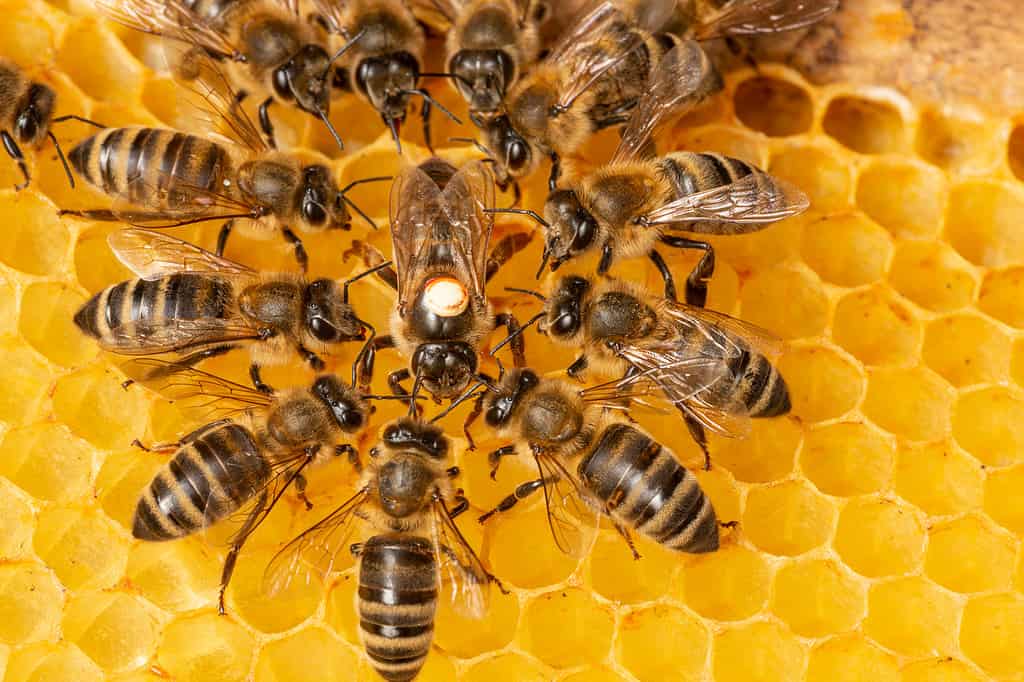
It is always best to have bees removed as the longer they remain, it is unlikely they will leave on their own.
©Kuttelvaserova Stuchelova/Shutterstock.com
Bees generally reside in walls because they are relatively safe – there are no harsh weather conditions to harm them or the colony. Just as with bee colonies located on farms, they prefer to live with untreated, older wood that is weathered. Each species has different preferences, like the bumble bees, which prefer nesting in insulation.
Once a bee has decided that your home will be there’s, it may not always be permanent. There are several factors that may lead to the abandonment of their colony. One of the top reasons they will leave is environmental stress. The colony may feel threatened due to loud noises, bad smells, parasites, or simply because the colony isn’t thriving. However, it is always best to have bees removed as the longer they remain, it is unlikely they will leave on their own.
Summary of How to Instantly Get Rid of Bees in a Wall
| Number | Ways To Get Rid of Bees |
|---|---|
| 1 | Investigate the Bees’ Exact Location |
| 2 | Chemical Sprays |
| 3 | Smoke |
| 4 | Borax Powder |
| 5 | Use the Trap-Out Method |
| 6 | Use a Cucumber |
| 7 | Use a Bee Vacuum |
| 8 | Liquid Soap and Water |
| 9 | Call a Professional |
The photo featured at the top of this post is © iStock.com/D-Steinmeyer
Thank you for reading! Have some feedback for us? Contact the AZ Animals editorial team.



